Analysis of Three Case Studies
VerifiedAdded on 2023/06/10
|10
|2528
|55
AI Summary
This article presents an analysis of three case studies on Grave’s disease, lymphoedema, and urinary tract infection. It discusses the nursing interventions, healthcare professionals, and associated risks. The article also provides information on the causes, symptoms, and diagnosis of these conditions.
Contribute Materials
Your contribution can guide someone’s learning journey. Share your
documents today.

Running head: CASE STUDY
Analysis of three case studies
Name of the Student
Name of the University
Author Note
Analysis of three case studies
Name of the Student
Name of the University
Author Note
Secure Best Marks with AI Grader
Need help grading? Try our AI Grader for instant feedback on your assignments.
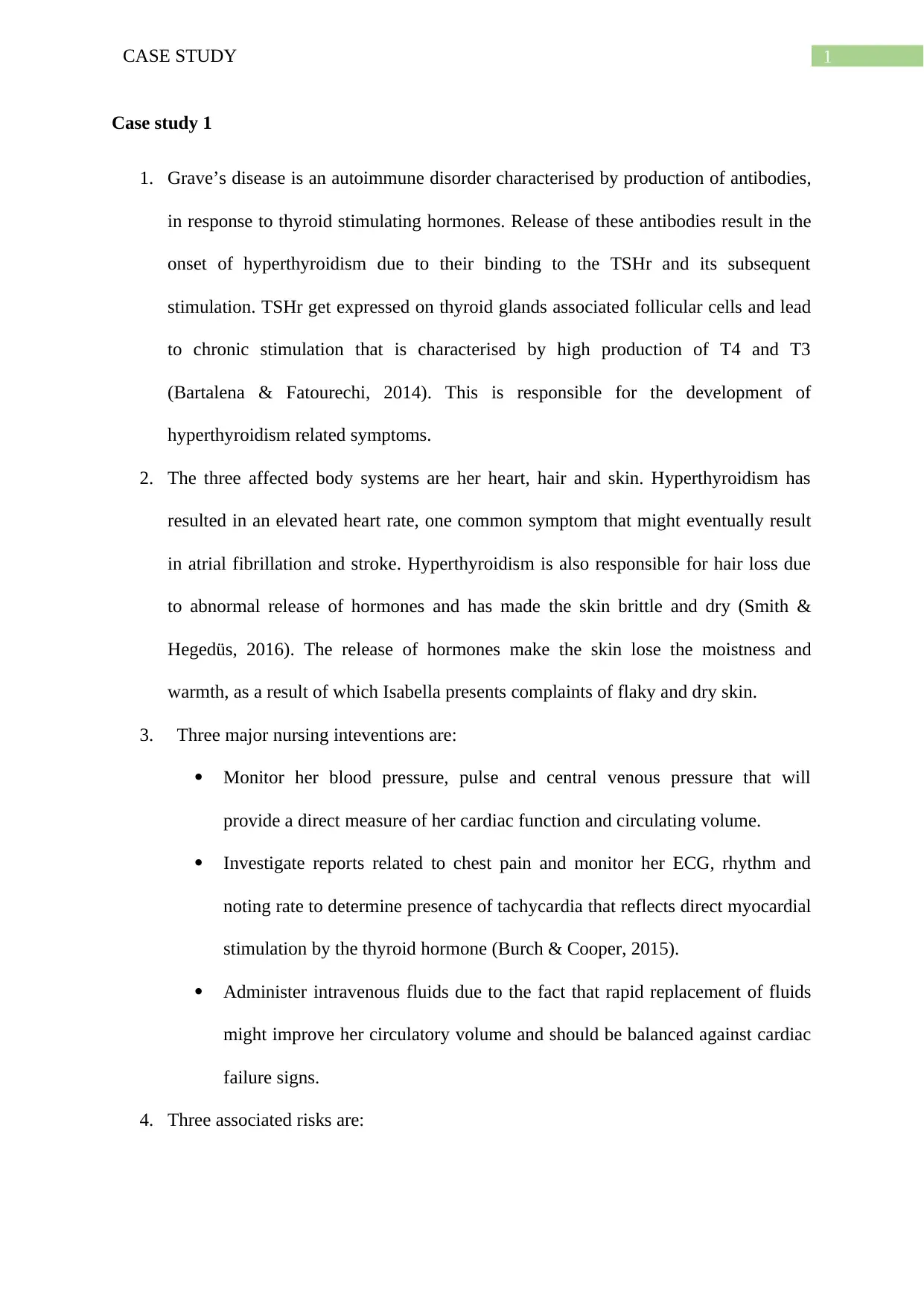
1CASE STUDY
Case study 1
1. Grave’s disease is an autoimmune disorder characterised by production of antibodies,
in response to thyroid stimulating hormones. Release of these antibodies result in the
onset of hyperthyroidism due to their binding to the TSHr and its subsequent
stimulation. TSHr get expressed on thyroid glands associated follicular cells and lead
to chronic stimulation that is characterised by high production of T4 and T3
(Bartalena & Fatourechi, 2014). This is responsible for the development of
hyperthyroidism related symptoms.
2. The three affected body systems are her heart, hair and skin. Hyperthyroidism has
resulted in an elevated heart rate, one common symptom that might eventually result
in atrial fibrillation and stroke. Hyperthyroidism is also responsible for hair loss due
to abnormal release of hormones and has made the skin brittle and dry (Smith &
Hegedüs, 2016). The release of hormones make the skin lose the moistness and
warmth, as a result of which Isabella presents complaints of flaky and dry skin.
3. Three major nursing inteventions are:
Monitor her blood pressure, pulse and central venous pressure that will
provide a direct measure of her cardiac function and circulating volume.
Investigate reports related to chest pain and monitor her ECG, rhythm and
noting rate to determine presence of tachycardia that reflects direct myocardial
stimulation by the thyroid hormone (Burch & Cooper, 2015).
Administer intravenous fluids due to the fact that rapid replacement of fluids
might improve her circulatory volume and should be balanced against cardiac
failure signs.
4. Three associated risks are:
Case study 1
1. Grave’s disease is an autoimmune disorder characterised by production of antibodies,
in response to thyroid stimulating hormones. Release of these antibodies result in the
onset of hyperthyroidism due to their binding to the TSHr and its subsequent
stimulation. TSHr get expressed on thyroid glands associated follicular cells and lead
to chronic stimulation that is characterised by high production of T4 and T3
(Bartalena & Fatourechi, 2014). This is responsible for the development of
hyperthyroidism related symptoms.
2. The three affected body systems are her heart, hair and skin. Hyperthyroidism has
resulted in an elevated heart rate, one common symptom that might eventually result
in atrial fibrillation and stroke. Hyperthyroidism is also responsible for hair loss due
to abnormal release of hormones and has made the skin brittle and dry (Smith &
Hegedüs, 2016). The release of hormones make the skin lose the moistness and
warmth, as a result of which Isabella presents complaints of flaky and dry skin.
3. Three major nursing inteventions are:
Monitor her blood pressure, pulse and central venous pressure that will
provide a direct measure of her cardiac function and circulating volume.
Investigate reports related to chest pain and monitor her ECG, rhythm and
noting rate to determine presence of tachycardia that reflects direct myocardial
stimulation by the thyroid hormone (Burch & Cooper, 2015).
Administer intravenous fluids due to the fact that rapid replacement of fluids
might improve her circulatory volume and should be balanced against cardiac
failure signs.
4. Three associated risks are:
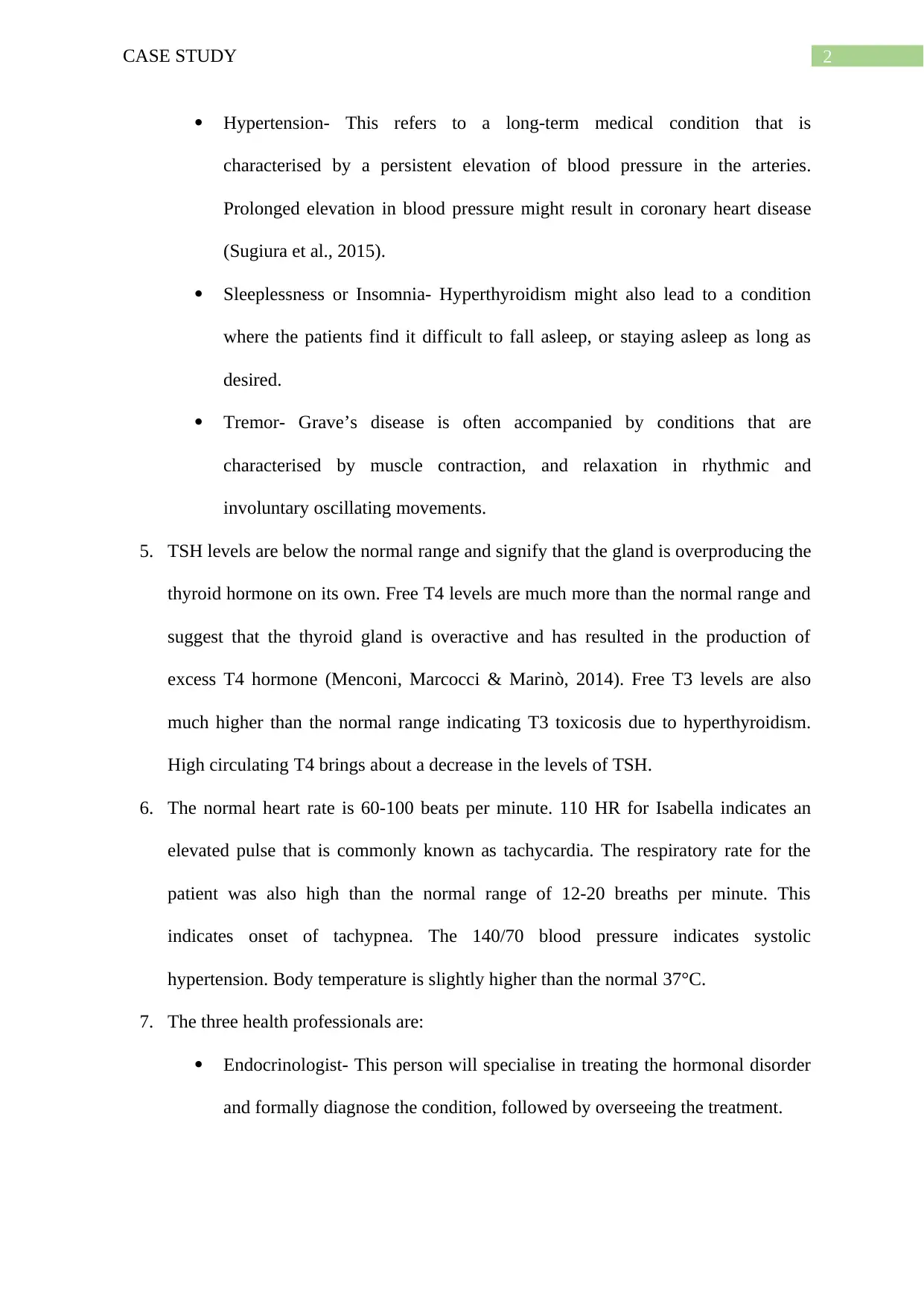
2CASE STUDY
Hypertension- This refers to a long-term medical condition that is
characterised by a persistent elevation of blood pressure in the arteries.
Prolonged elevation in blood pressure might result in coronary heart disease
(Sugiura et al., 2015).
Sleeplessness or Insomnia- Hyperthyroidism might also lead to a condition
where the patients find it difficult to fall asleep, or staying asleep as long as
desired.
Tremor- Grave’s disease is often accompanied by conditions that are
characterised by muscle contraction, and relaxation in rhythmic and
involuntary oscillating movements.
5. TSH levels are below the normal range and signify that the gland is overproducing the
thyroid hormone on its own. Free T4 levels are much more than the normal range and
suggest that the thyroid gland is overactive and has resulted in the production of
excess T4 hormone (Menconi, Marcocci & Marinò, 2014). Free T3 levels are also
much higher than the normal range indicating T3 toxicosis due to hyperthyroidism.
High circulating T4 brings about a decrease in the levels of TSH.
6. The normal heart rate is 60-100 beats per minute. 110 HR for Isabella indicates an
elevated pulse that is commonly known as tachycardia. The respiratory rate for the
patient was also high than the normal range of 12-20 breaths per minute. This
indicates onset of tachypnea. The 140/70 blood pressure indicates systolic
hypertension. Body temperature is slightly higher than the normal 37°C.
7. The three health professionals are:
Endocrinologist- This person will specialise in treating the hormonal disorder
and formally diagnose the condition, followed by overseeing the treatment.
Hypertension- This refers to a long-term medical condition that is
characterised by a persistent elevation of blood pressure in the arteries.
Prolonged elevation in blood pressure might result in coronary heart disease
(Sugiura et al., 2015).
Sleeplessness or Insomnia- Hyperthyroidism might also lead to a condition
where the patients find it difficult to fall asleep, or staying asleep as long as
desired.
Tremor- Grave’s disease is often accompanied by conditions that are
characterised by muscle contraction, and relaxation in rhythmic and
involuntary oscillating movements.
5. TSH levels are below the normal range and signify that the gland is overproducing the
thyroid hormone on its own. Free T4 levels are much more than the normal range and
suggest that the thyroid gland is overactive and has resulted in the production of
excess T4 hormone (Menconi, Marcocci & Marinò, 2014). Free T3 levels are also
much higher than the normal range indicating T3 toxicosis due to hyperthyroidism.
High circulating T4 brings about a decrease in the levels of TSH.
6. The normal heart rate is 60-100 beats per minute. 110 HR for Isabella indicates an
elevated pulse that is commonly known as tachycardia. The respiratory rate for the
patient was also high than the normal range of 12-20 breaths per minute. This
indicates onset of tachypnea. The 140/70 blood pressure indicates systolic
hypertension. Body temperature is slightly higher than the normal 37°C.
7. The three health professionals are:
Endocrinologist- This person will specialise in treating the hormonal disorder
and formally diagnose the condition, followed by overseeing the treatment.
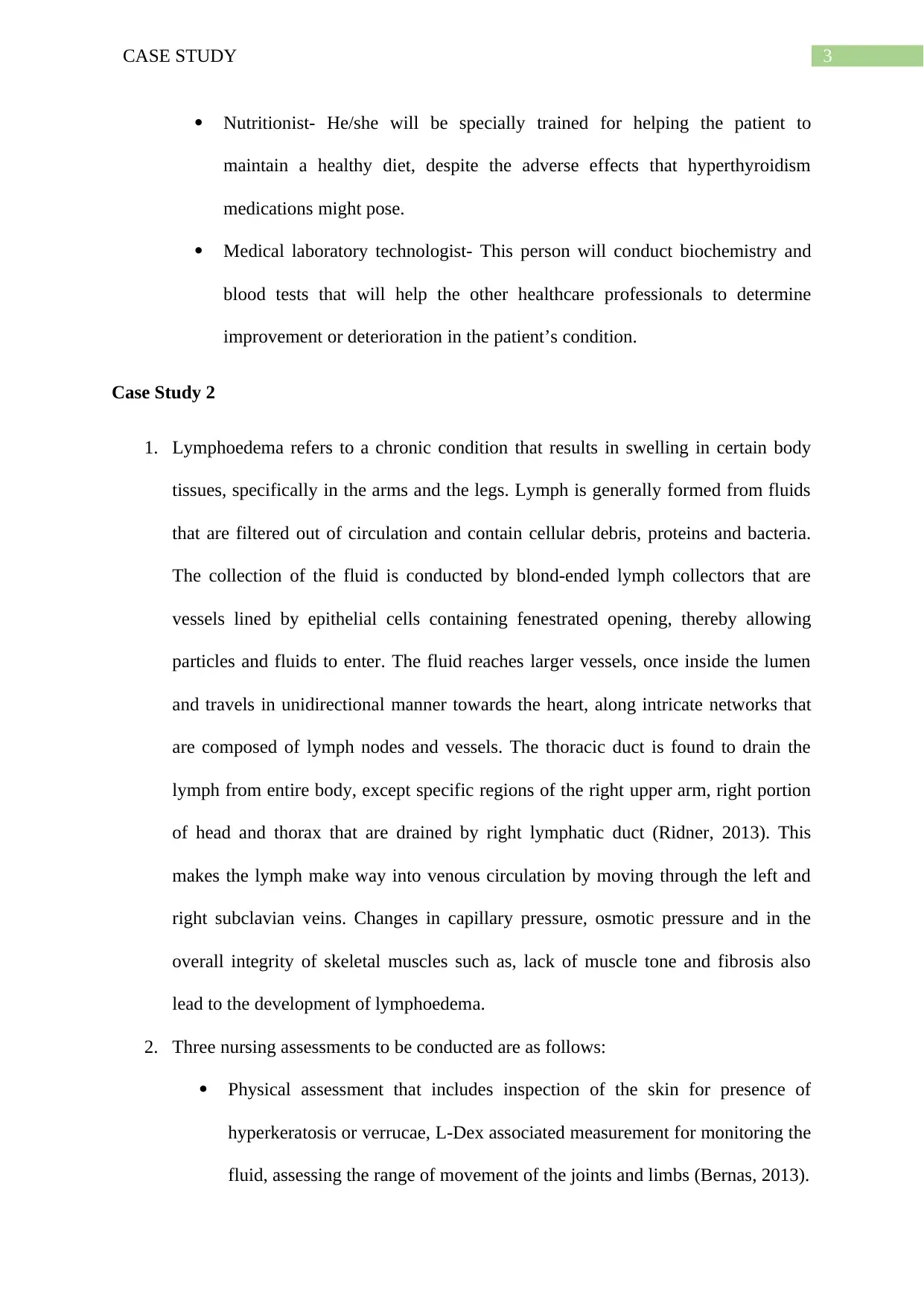
3CASE STUDY
Nutritionist- He/she will be specially trained for helping the patient to
maintain a healthy diet, despite the adverse effects that hyperthyroidism
medications might pose.
Medical laboratory technologist- This person will conduct biochemistry and
blood tests that will help the other healthcare professionals to determine
improvement or deterioration in the patient’s condition.
Case Study 2
1. Lymphoedema refers to a chronic condition that results in swelling in certain body
tissues, specifically in the arms and the legs. Lymph is generally formed from fluids
that are filtered out of circulation and contain cellular debris, proteins and bacteria.
The collection of the fluid is conducted by blond-ended lymph collectors that are
vessels lined by epithelial cells containing fenestrated opening, thereby allowing
particles and fluids to enter. The fluid reaches larger vessels, once inside the lumen
and travels in unidirectional manner towards the heart, along intricate networks that
are composed of lymph nodes and vessels. The thoracic duct is found to drain the
lymph from entire body, except specific regions of the right upper arm, right portion
of head and thorax that are drained by right lymphatic duct (Ridner, 2013). This
makes the lymph make way into venous circulation by moving through the left and
right subclavian veins. Changes in capillary pressure, osmotic pressure and in the
overall integrity of skeletal muscles such as, lack of muscle tone and fibrosis also
lead to the development of lymphoedema.
2. Three nursing assessments to be conducted are as follows:
Physical assessment that includes inspection of the skin for presence of
hyperkeratosis or verrucae, L-Dex associated measurement for monitoring the
fluid, assessing the range of movement of the joints and limbs (Bernas, 2013).
Nutritionist- He/she will be specially trained for helping the patient to
maintain a healthy diet, despite the adverse effects that hyperthyroidism
medications might pose.
Medical laboratory technologist- This person will conduct biochemistry and
blood tests that will help the other healthcare professionals to determine
improvement or deterioration in the patient’s condition.
Case Study 2
1. Lymphoedema refers to a chronic condition that results in swelling in certain body
tissues, specifically in the arms and the legs. Lymph is generally formed from fluids
that are filtered out of circulation and contain cellular debris, proteins and bacteria.
The collection of the fluid is conducted by blond-ended lymph collectors that are
vessels lined by epithelial cells containing fenestrated opening, thereby allowing
particles and fluids to enter. The fluid reaches larger vessels, once inside the lumen
and travels in unidirectional manner towards the heart, along intricate networks that
are composed of lymph nodes and vessels. The thoracic duct is found to drain the
lymph from entire body, except specific regions of the right upper arm, right portion
of head and thorax that are drained by right lymphatic duct (Ridner, 2013). This
makes the lymph make way into venous circulation by moving through the left and
right subclavian veins. Changes in capillary pressure, osmotic pressure and in the
overall integrity of skeletal muscles such as, lack of muscle tone and fibrosis also
lead to the development of lymphoedema.
2. Three nursing assessments to be conducted are as follows:
Physical assessment that includes inspection of the skin for presence of
hyperkeratosis or verrucae, L-Dex associated measurement for monitoring the
fluid, assessing the range of movement of the joints and limbs (Bernas, 2013).
Secure Best Marks with AI Grader
Need help grading? Try our AI Grader for instant feedback on your assignments.
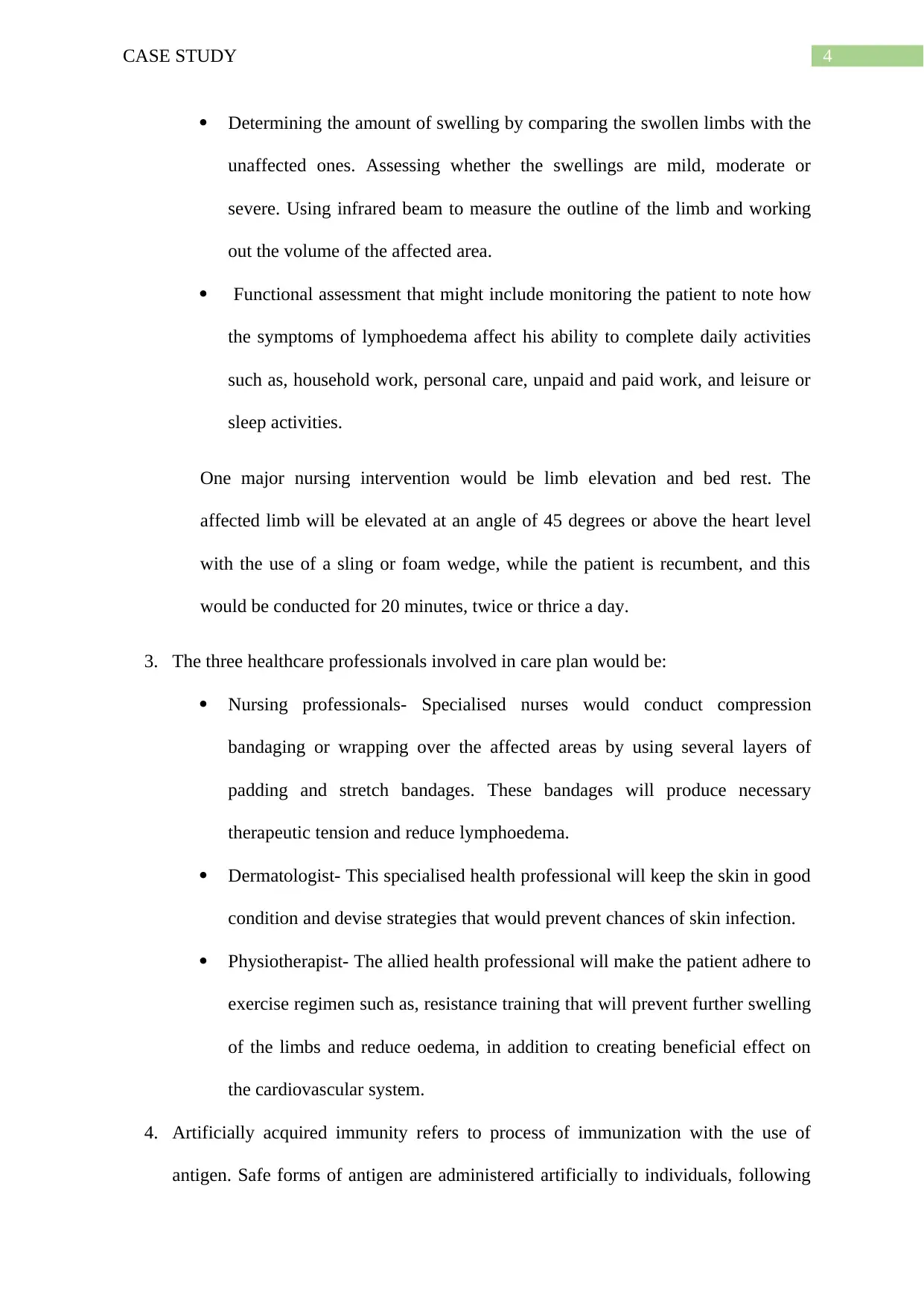
4CASE STUDY
Determining the amount of swelling by comparing the swollen limbs with the
unaffected ones. Assessing whether the swellings are mild, moderate or
severe. Using infrared beam to measure the outline of the limb and working
out the volume of the affected area.
Functional assessment that might include monitoring the patient to note how
the symptoms of lymphoedema affect his ability to complete daily activities
such as, household work, personal care, unpaid and paid work, and leisure or
sleep activities.
One major nursing intervention would be limb elevation and bed rest. The
affected limb will be elevated at an angle of 45 degrees or above the heart level
with the use of a sling or foam wedge, while the patient is recumbent, and this
would be conducted for 20 minutes, twice or thrice a day.
3. The three healthcare professionals involved in care plan would be:
Nursing professionals- Specialised nurses would conduct compression
bandaging or wrapping over the affected areas by using several layers of
padding and stretch bandages. These bandages will produce necessary
therapeutic tension and reduce lymphoedema.
Dermatologist- This specialised health professional will keep the skin in good
condition and devise strategies that would prevent chances of skin infection.
Physiotherapist- The allied health professional will make the patient adhere to
exercise regimen such as, resistance training that will prevent further swelling
of the limbs and reduce oedema, in addition to creating beneficial effect on
the cardiovascular system.
4. Artificially acquired immunity refers to process of immunization with the use of
antigen. Safe forms of antigen are administered artificially to individuals, following
Determining the amount of swelling by comparing the swollen limbs with the
unaffected ones. Assessing whether the swellings are mild, moderate or
severe. Using infrared beam to measure the outline of the limb and working
out the volume of the affected area.
Functional assessment that might include monitoring the patient to note how
the symptoms of lymphoedema affect his ability to complete daily activities
such as, household work, personal care, unpaid and paid work, and leisure or
sleep activities.
One major nursing intervention would be limb elevation and bed rest. The
affected limb will be elevated at an angle of 45 degrees or above the heart level
with the use of a sling or foam wedge, while the patient is recumbent, and this
would be conducted for 20 minutes, twice or thrice a day.
3. The three healthcare professionals involved in care plan would be:
Nursing professionals- Specialised nurses would conduct compression
bandaging or wrapping over the affected areas by using several layers of
padding and stretch bandages. These bandages will produce necessary
therapeutic tension and reduce lymphoedema.
Dermatologist- This specialised health professional will keep the skin in good
condition and devise strategies that would prevent chances of skin infection.
Physiotherapist- The allied health professional will make the patient adhere to
exercise regimen such as, resistance training that will prevent further swelling
of the limbs and reduce oedema, in addition to creating beneficial effect on
the cardiovascular system.
4. Artificially acquired immunity refers to process of immunization with the use of
antigen. Safe forms of antigen are administered artificially to individuals, following
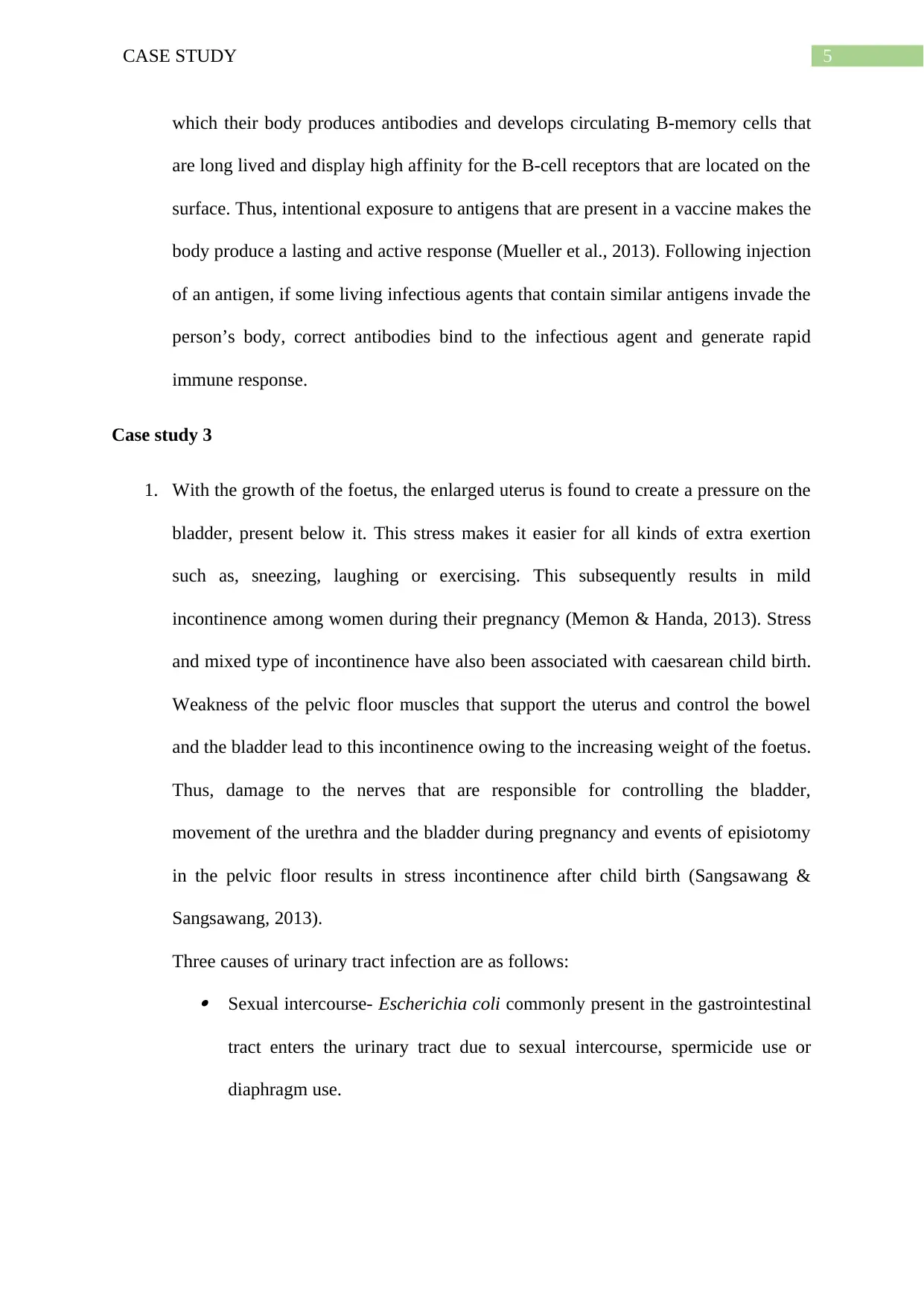
5CASE STUDY
which their body produces antibodies and develops circulating B-memory cells that
are long lived and display high affinity for the B-cell receptors that are located on the
surface. Thus, intentional exposure to antigens that are present in a vaccine makes the
body produce a lasting and active response (Mueller et al., 2013). Following injection
of an antigen, if some living infectious agents that contain similar antigens invade the
person’s body, correct antibodies bind to the infectious agent and generate rapid
immune response.
Case study 3
1. With the growth of the foetus, the enlarged uterus is found to create a pressure on the
bladder, present below it. This stress makes it easier for all kinds of extra exertion
such as, sneezing, laughing or exercising. This subsequently results in mild
incontinence among women during their pregnancy (Memon & Handa, 2013). Stress
and mixed type of incontinence have also been associated with caesarean child birth.
Weakness of the pelvic floor muscles that support the uterus and control the bowel
and the bladder lead to this incontinence owing to the increasing weight of the foetus.
Thus, damage to the nerves that are responsible for controlling the bladder,
movement of the urethra and the bladder during pregnancy and events of episiotomy
in the pelvic floor results in stress incontinence after child birth (Sangsawang &
Sangsawang, 2013).
Three causes of urinary tract infection are as follows:
Sexual intercourse- Escherichia coli commonly present in the gastrointestinal
tract enters the urinary tract due to sexual intercourse, spermicide use or
diaphragm use.
which their body produces antibodies and develops circulating B-memory cells that
are long lived and display high affinity for the B-cell receptors that are located on the
surface. Thus, intentional exposure to antigens that are present in a vaccine makes the
body produce a lasting and active response (Mueller et al., 2013). Following injection
of an antigen, if some living infectious agents that contain similar antigens invade the
person’s body, correct antibodies bind to the infectious agent and generate rapid
immune response.
Case study 3
1. With the growth of the foetus, the enlarged uterus is found to create a pressure on the
bladder, present below it. This stress makes it easier for all kinds of extra exertion
such as, sneezing, laughing or exercising. This subsequently results in mild
incontinence among women during their pregnancy (Memon & Handa, 2013). Stress
and mixed type of incontinence have also been associated with caesarean child birth.
Weakness of the pelvic floor muscles that support the uterus and control the bowel
and the bladder lead to this incontinence owing to the increasing weight of the foetus.
Thus, damage to the nerves that are responsible for controlling the bladder,
movement of the urethra and the bladder during pregnancy and events of episiotomy
in the pelvic floor results in stress incontinence after child birth (Sangsawang &
Sangsawang, 2013).
Three causes of urinary tract infection are as follows:
Sexual intercourse- Escherichia coli commonly present in the gastrointestinal
tract enters the urinary tract due to sexual intercourse, spermicide use or
diaphragm use.
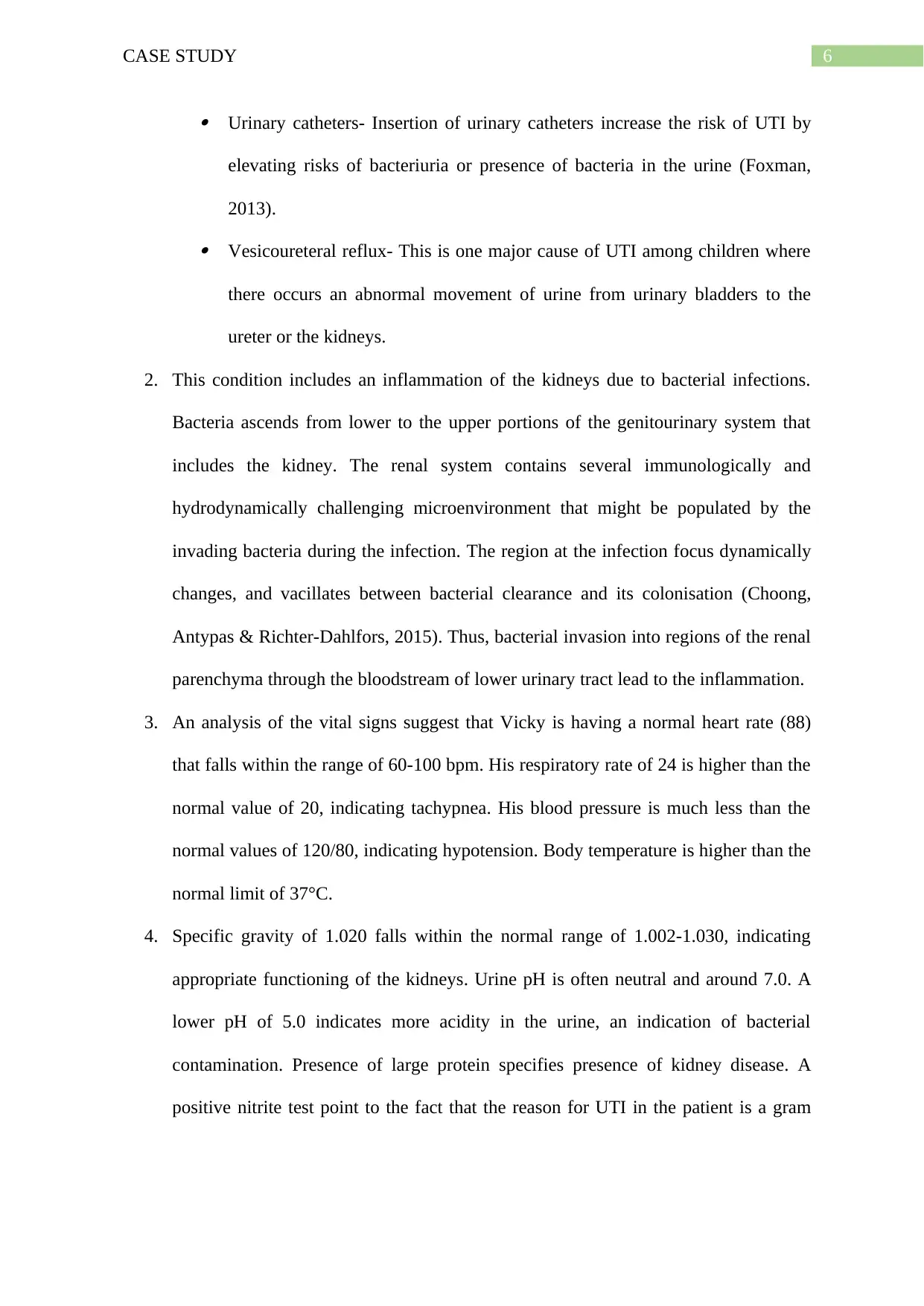
6CASE STUDY
Urinary catheters- Insertion of urinary catheters increase the risk of UTI by
elevating risks of bacteriuria or presence of bacteria in the urine (Foxman,
2013).
Vesicoureteral reflux- This is one major cause of UTI among children where
there occurs an abnormal movement of urine from urinary bladders to the
ureter or the kidneys.
2. This condition includes an inflammation of the kidneys due to bacterial infections.
Bacteria ascends from lower to the upper portions of the genitourinary system that
includes the kidney. The renal system contains several immunologically and
hydrodynamically challenging microenvironment that might be populated by the
invading bacteria during the infection. The region at the infection focus dynamically
changes, and vacillates between bacterial clearance and its colonisation (Choong,
Antypas & Richter-Dahlfors, 2015). Thus, bacterial invasion into regions of the renal
parenchyma through the bloodstream of lower urinary tract lead to the inflammation.
3. An analysis of the vital signs suggest that Vicky is having a normal heart rate (88)
that falls within the range of 60-100 bpm. His respiratory rate of 24 is higher than the
normal value of 20, indicating tachypnea. His blood pressure is much less than the
normal values of 120/80, indicating hypotension. Body temperature is higher than the
normal limit of 37°C.
4. Specific gravity of 1.020 falls within the normal range of 1.002-1.030, indicating
appropriate functioning of the kidneys. Urine pH is often neutral and around 7.0. A
lower pH of 5.0 indicates more acidity in the urine, an indication of bacterial
contamination. Presence of large protein specifies presence of kidney disease. A
positive nitrite test point to the fact that the reason for UTI in the patient is a gram
Urinary catheters- Insertion of urinary catheters increase the risk of UTI by
elevating risks of bacteriuria or presence of bacteria in the urine (Foxman,
2013).
Vesicoureteral reflux- This is one major cause of UTI among children where
there occurs an abnormal movement of urine from urinary bladders to the
ureter or the kidneys.
2. This condition includes an inflammation of the kidneys due to bacterial infections.
Bacteria ascends from lower to the upper portions of the genitourinary system that
includes the kidney. The renal system contains several immunologically and
hydrodynamically challenging microenvironment that might be populated by the
invading bacteria during the infection. The region at the infection focus dynamically
changes, and vacillates between bacterial clearance and its colonisation (Choong,
Antypas & Richter-Dahlfors, 2015). Thus, bacterial invasion into regions of the renal
parenchyma through the bloodstream of lower urinary tract lead to the inflammation.
3. An analysis of the vital signs suggest that Vicky is having a normal heart rate (88)
that falls within the range of 60-100 bpm. His respiratory rate of 24 is higher than the
normal value of 20, indicating tachypnea. His blood pressure is much less than the
normal values of 120/80, indicating hypotension. Body temperature is higher than the
normal limit of 37°C.
4. Specific gravity of 1.020 falls within the normal range of 1.002-1.030, indicating
appropriate functioning of the kidneys. Urine pH is often neutral and around 7.0. A
lower pH of 5.0 indicates more acidity in the urine, an indication of bacterial
contamination. Presence of large protein specifies presence of kidney disease. A
positive nitrite test point to the fact that the reason for UTI in the patient is a gram
Paraphrase This Document
Need a fresh take? Get an instant paraphrase of this document with our AI Paraphraser
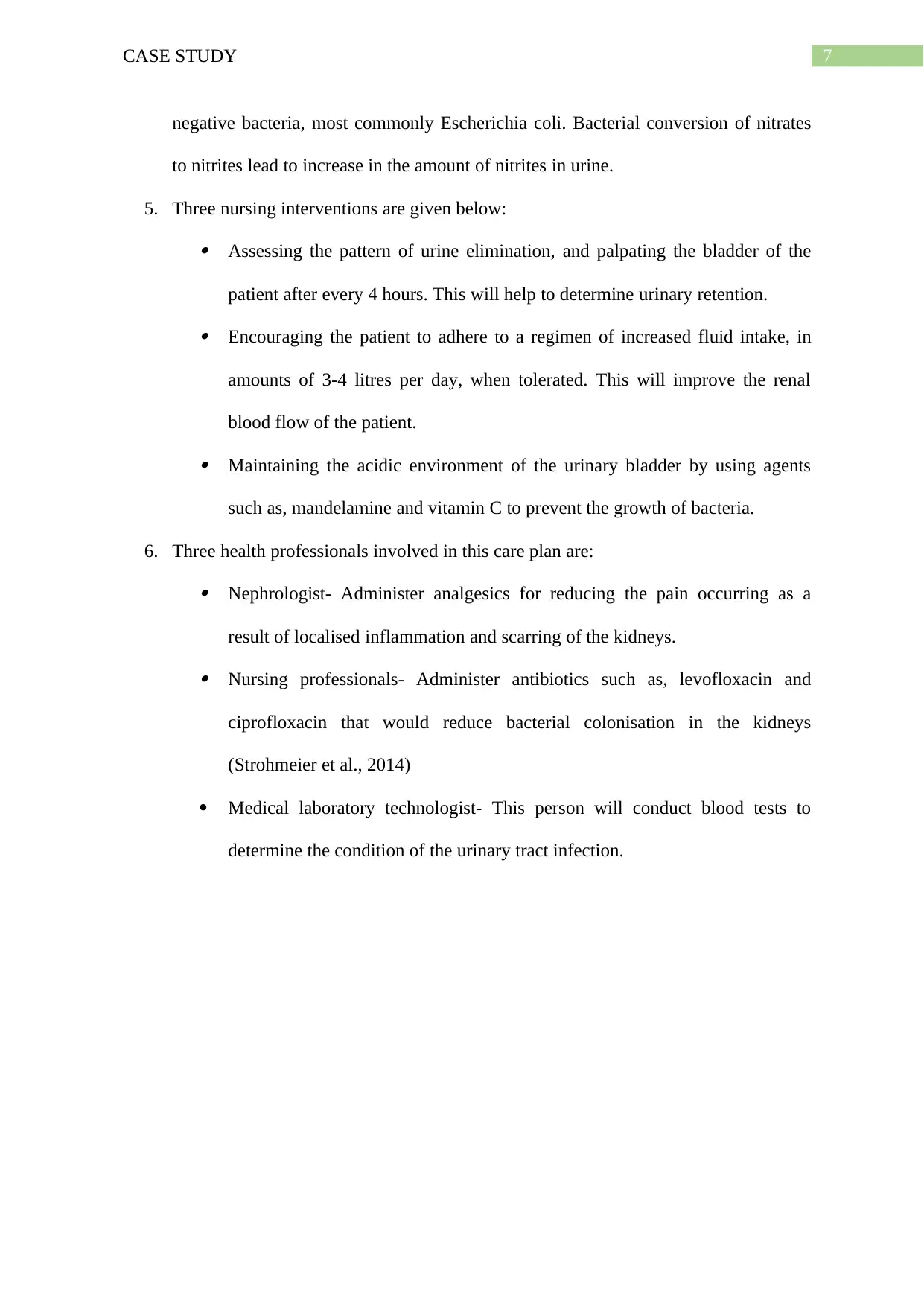
7CASE STUDY
negative bacteria, most commonly Escherichia coli. Bacterial conversion of nitrates
to nitrites lead to increase in the amount of nitrites in urine.
5. Three nursing interventions are given below:
Assessing the pattern of urine elimination, and palpating the bladder of the
patient after every 4 hours. This will help to determine urinary retention.
Encouraging the patient to adhere to a regimen of increased fluid intake, in
amounts of 3-4 litres per day, when tolerated. This will improve the renal
blood flow of the patient.
Maintaining the acidic environment of the urinary bladder by using agents
such as, mandelamine and vitamin C to prevent the growth of bacteria.
6. Three health professionals involved in this care plan are:
Nephrologist- Administer analgesics for reducing the pain occurring as a
result of localised inflammation and scarring of the kidneys.
Nursing professionals- Administer antibiotics such as, levofloxacin and
ciprofloxacin that would reduce bacterial colonisation in the kidneys
(Strohmeier et al., 2014)
Medical laboratory technologist- This person will conduct blood tests to
determine the condition of the urinary tract infection.
negative bacteria, most commonly Escherichia coli. Bacterial conversion of nitrates
to nitrites lead to increase in the amount of nitrites in urine.
5. Three nursing interventions are given below:
Assessing the pattern of urine elimination, and palpating the bladder of the
patient after every 4 hours. This will help to determine urinary retention.
Encouraging the patient to adhere to a regimen of increased fluid intake, in
amounts of 3-4 litres per day, when tolerated. This will improve the renal
blood flow of the patient.
Maintaining the acidic environment of the urinary bladder by using agents
such as, mandelamine and vitamin C to prevent the growth of bacteria.
6. Three health professionals involved in this care plan are:
Nephrologist- Administer analgesics for reducing the pain occurring as a
result of localised inflammation and scarring of the kidneys.
Nursing professionals- Administer antibiotics such as, levofloxacin and
ciprofloxacin that would reduce bacterial colonisation in the kidneys
(Strohmeier et al., 2014)
Medical laboratory technologist- This person will conduct blood tests to
determine the condition of the urinary tract infection.
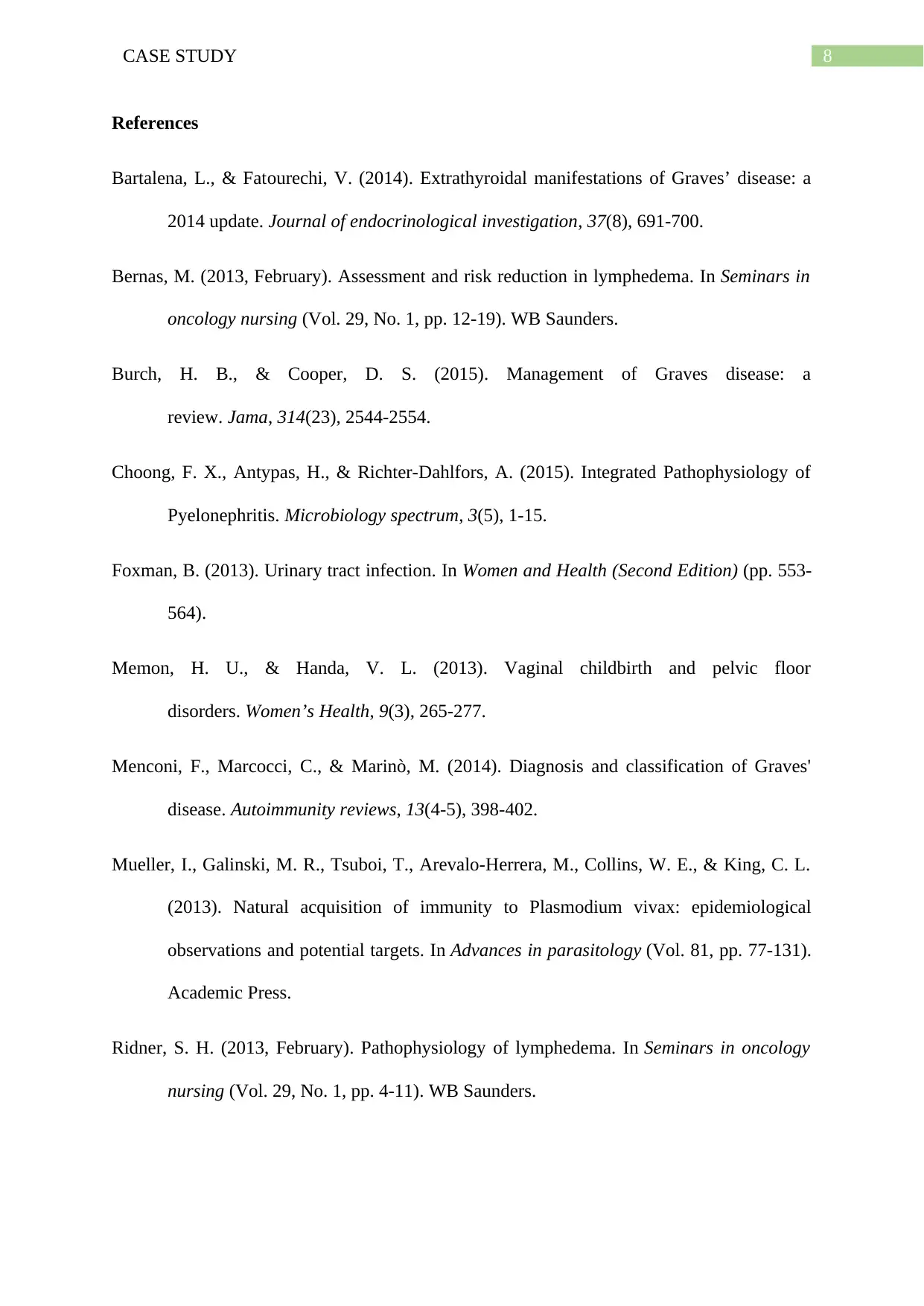
8CASE STUDY
References
Bartalena, L., & Fatourechi, V. (2014). Extrathyroidal manifestations of Graves’ disease: a
2014 update. Journal of endocrinological investigation, 37(8), 691-700.
Bernas, M. (2013, February). Assessment and risk reduction in lymphedema. In Seminars in
oncology nursing (Vol. 29, No. 1, pp. 12-19). WB Saunders.
Burch, H. B., & Cooper, D. S. (2015). Management of Graves disease: a
review. Jama, 314(23), 2544-2554.
Choong, F. X., Antypas, H., & Richter-Dahlfors, A. (2015). Integrated Pathophysiology of
Pyelonephritis. Microbiology spectrum, 3(5), 1-15.
Foxman, B. (2013). Urinary tract infection. In Women and Health (Second Edition) (pp. 553-
564).
Memon, H. U., & Handa, V. L. (2013). Vaginal childbirth and pelvic floor
disorders. Women’s Health, 9(3), 265-277.
Menconi, F., Marcocci, C., & Marinò, M. (2014). Diagnosis and classification of Graves'
disease. Autoimmunity reviews, 13(4-5), 398-402.
Mueller, I., Galinski, M. R., Tsuboi, T., Arevalo-Herrera, M., Collins, W. E., & King, C. L.
(2013). Natural acquisition of immunity to Plasmodium vivax: epidemiological
observations and potential targets. In Advances in parasitology (Vol. 81, pp. 77-131).
Academic Press.
Ridner, S. H. (2013, February). Pathophysiology of lymphedema. In Seminars in oncology
nursing (Vol. 29, No. 1, pp. 4-11). WB Saunders.
References
Bartalena, L., & Fatourechi, V. (2014). Extrathyroidal manifestations of Graves’ disease: a
2014 update. Journal of endocrinological investigation, 37(8), 691-700.
Bernas, M. (2013, February). Assessment and risk reduction in lymphedema. In Seminars in
oncology nursing (Vol. 29, No. 1, pp. 12-19). WB Saunders.
Burch, H. B., & Cooper, D. S. (2015). Management of Graves disease: a
review. Jama, 314(23), 2544-2554.
Choong, F. X., Antypas, H., & Richter-Dahlfors, A. (2015). Integrated Pathophysiology of
Pyelonephritis. Microbiology spectrum, 3(5), 1-15.
Foxman, B. (2013). Urinary tract infection. In Women and Health (Second Edition) (pp. 553-
564).
Memon, H. U., & Handa, V. L. (2013). Vaginal childbirth and pelvic floor
disorders. Women’s Health, 9(3), 265-277.
Menconi, F., Marcocci, C., & Marinò, M. (2014). Diagnosis and classification of Graves'
disease. Autoimmunity reviews, 13(4-5), 398-402.
Mueller, I., Galinski, M. R., Tsuboi, T., Arevalo-Herrera, M., Collins, W. E., & King, C. L.
(2013). Natural acquisition of immunity to Plasmodium vivax: epidemiological
observations and potential targets. In Advances in parasitology (Vol. 81, pp. 77-131).
Academic Press.
Ridner, S. H. (2013, February). Pathophysiology of lymphedema. In Seminars in oncology
nursing (Vol. 29, No. 1, pp. 4-11). WB Saunders.
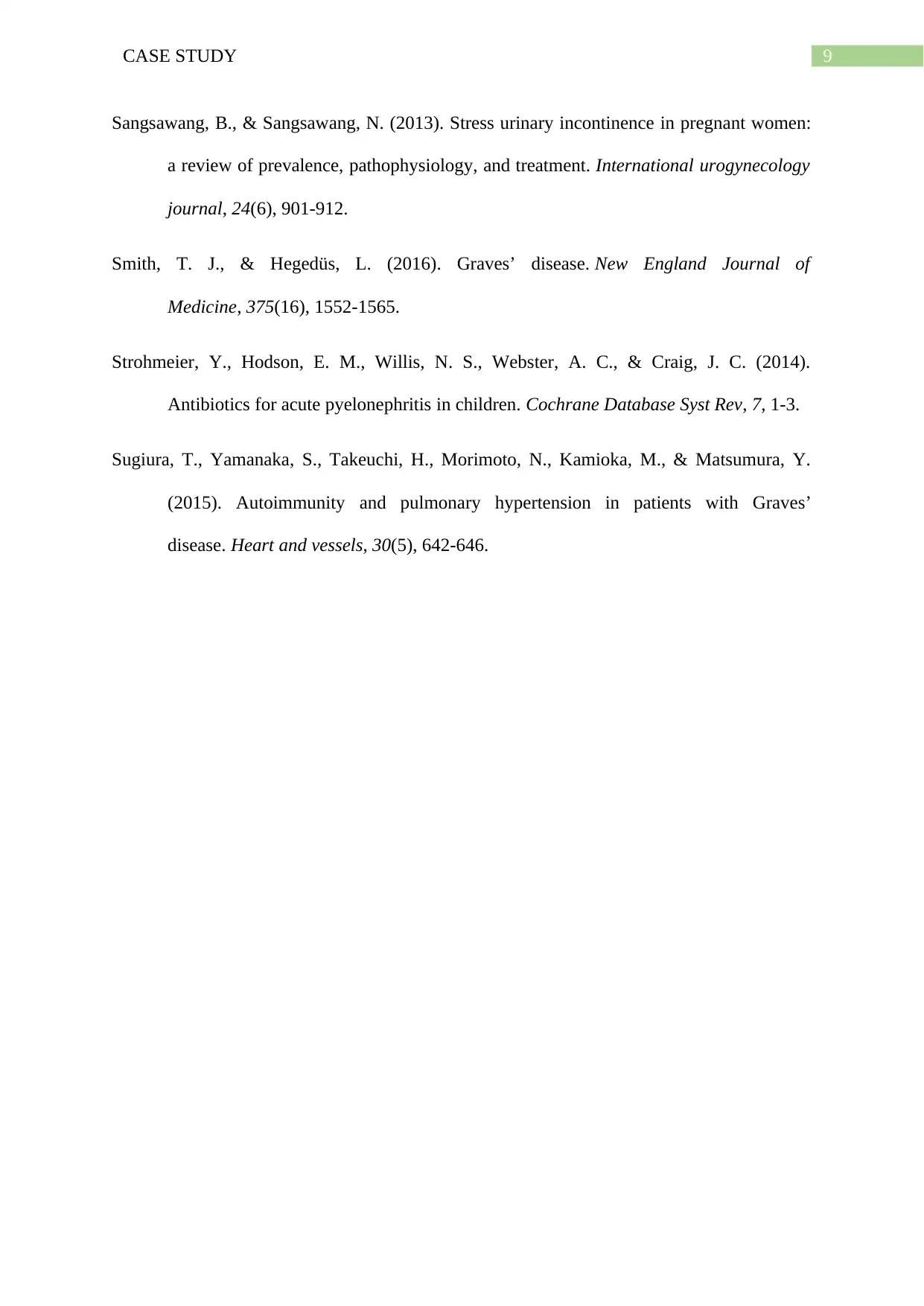
9CASE STUDY
Sangsawang, B., & Sangsawang, N. (2013). Stress urinary incontinence in pregnant women:
a review of prevalence, pathophysiology, and treatment. International urogynecology
journal, 24(6), 901-912.
Smith, T. J., & Hegedüs, L. (2016). Graves’ disease. New England Journal of
Medicine, 375(16), 1552-1565.
Strohmeier, Y., Hodson, E. M., Willis, N. S., Webster, A. C., & Craig, J. C. (2014).
Antibiotics for acute pyelonephritis in children. Cochrane Database Syst Rev, 7, 1-3.
Sugiura, T., Yamanaka, S., Takeuchi, H., Morimoto, N., Kamioka, M., & Matsumura, Y.
(2015). Autoimmunity and pulmonary hypertension in patients with Graves’
disease. Heart and vessels, 30(5), 642-646.
Sangsawang, B., & Sangsawang, N. (2013). Stress urinary incontinence in pregnant women:
a review of prevalence, pathophysiology, and treatment. International urogynecology
journal, 24(6), 901-912.
Smith, T. J., & Hegedüs, L. (2016). Graves’ disease. New England Journal of
Medicine, 375(16), 1552-1565.
Strohmeier, Y., Hodson, E. M., Willis, N. S., Webster, A. C., & Craig, J. C. (2014).
Antibiotics for acute pyelonephritis in children. Cochrane Database Syst Rev, 7, 1-3.
Sugiura, T., Yamanaka, S., Takeuchi, H., Morimoto, N., Kamioka, M., & Matsumura, Y.
(2015). Autoimmunity and pulmonary hypertension in patients with Graves’
disease. Heart and vessels, 30(5), 642-646.
1 out of 10
Related Documents
Your All-in-One AI-Powered Toolkit for Academic Success.
+13062052269
info@desklib.com
Available 24*7 on WhatsApp / Email
![[object Object]](/_next/static/media/star-bottom.7253800d.svg)
Unlock your academic potential
© 2024 | Zucol Services PVT LTD | All rights reserved.





